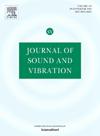Tuned inerter viscoelastic liquid column dampers
IF 4.3
2区 工程技术
Q1 ACOUSTICS
引用次数: 0
Abstract
Structural vibration control remains a major challenge in engineering, particularly for buildings exposed to dynamic excitations. While conventional Tuned Liquid Column Dampers (TLCDs) and inerter-based TLCDs offer passive damping solutions, they are limited in simultaneously optimising inertial and damping effects. This study proposes Tuned Inerter Viscoelastic Liquid Column Dampers (TIVLCDs), a novel class of passive dampers combining inerters with viscoelastic materials to enhance energy dissipation. Closed-form expressions for optimal design parameters are derived using statistical linearisation and optimisation. Frequency domain analyses show that the V-shaped TIVLCD achieves peak displacement reductions of 96.93% and 96.43%, and acceleration reductions of 78.40% and 81.82%, compared to TLCD and TLCDI, respectively. Time history analyses under real earthquake ground motions reveal displacement reductions of 27.35% and 29.36%, and acceleration reductions of 22.99% and 27.17%, for U-shaped and V-shaped TIVLCDs relative to TLCDI. These improvements are attributed to the enhanced coupling between inertial, viscoelastic, and gravitational effects. The findings demonstrate that TIVLCDs, particularly the V-shaped design, provide significantly better vibration and acceleration mitigation than existing solutions, establishing them as an effective and adaptable tool for passive structural control under seismic loading.
可调谐干涉粘弹性液柱阻尼器
结构振动控制仍然是工程中的主要挑战,特别是对于处于动力激励下的建筑物。虽然传统的调谐液柱阻尼器(tlcd)和基于干涉的tlcd提供了被动阻尼解决方案,但它们在同时优化惯性和阻尼效果方面受到限制。本文提出了一种将阻尼器与粘弹性材料相结合的新型无源阻尼器——调谐式阻尼器粘弹性液柱阻尼器(tivlcd)。利用统计线性化和H∞优化,导出了最优设计参数的封闭表达式。频域分析表明,与TLCD和TLCDI相比,v型TIVLCD的峰值位移分别降低了96.93%和96.43%,加速度分别降低了78.40%和81.82%。实际地震地震动时程分析表明,u型和v型tilcd相对于TLCDI,位移减少27.35%和29.36%,加速度减少22.99%和27.17%。这些改进是由于惯性、粘弹性和引力效应之间的耦合增强。研究结果表明,与现有的解决方案相比,tivlcd,特别是v形设计,提供了更好的振动和加速度缓解,使其成为地震荷载下被动结构控制的有效且适应性强的工具。
本文章由计算机程序翻译,如有差异,请以英文原文为准。
求助全文
约1分钟内获得全文
求助全文
来源期刊

Journal of Sound and Vibration
工程技术-工程:机械
CiteScore
9.10
自引率
10.60%
发文量
551
审稿时长
69 days
期刊介绍:
The Journal of Sound and Vibration (JSV) is an independent journal devoted to the prompt publication of original papers, both theoretical and experimental, that provide new information on any aspect of sound or vibration. There is an emphasis on fundamental work that has potential for practical application.
JSV was founded and operates on the premise that the subject of sound and vibration requires a journal that publishes papers of a high technical standard across the various subdisciplines, thus facilitating awareness of techniques and discoveries in one area that may be applicable in others.
 求助内容:
求助内容: 应助结果提醒方式:
应助结果提醒方式:


